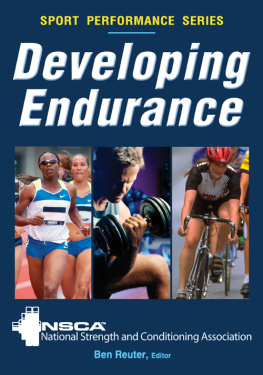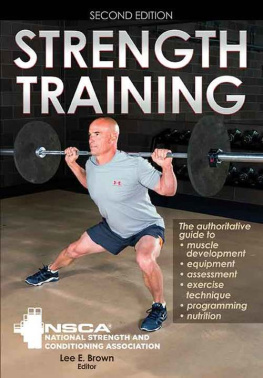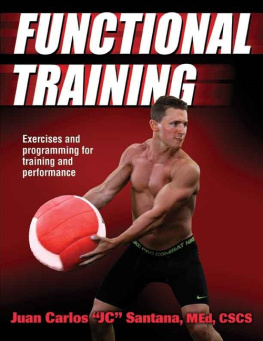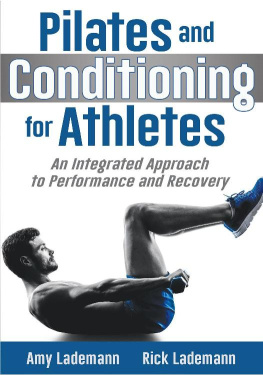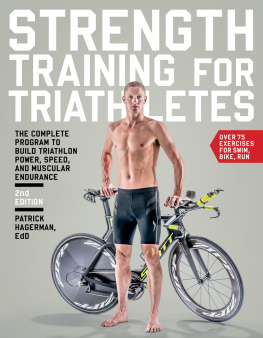Library of Congress Cataloging-in-Publication Data
Developing endurance / National Strength and Conditioning Association (NSCA) ; Ben Reuter, editor.
p. cm. -- (Sport performance series)
Includes bibliographical references and index.
ISBN-13: 978-0-7360-8327-0 (soft cover)
ISBN-10: 0-7360-8327-8 (soft cover)
1. Physical fitness. 2. Physical education and training--Physiological aspects. 3. Exercise--Physiological aspects. 4. Endurance sports. I. Reuter, Ben. II. National Strength & Conditioning Association (U.S.)
GV481.D47 2012
613.7--dc23
2011044117
ISBN-10: 0-7360-8327-8 (print)
ISBN-13: 978-0-7360-8327-0 (print)
Copyright 2012 by National Strength and Conditioning Association
All rights reserved. Except for use in a review, the reproduction or utilization of this work in any form or by any electronic, mechanical, or other means, now known or hereafter invented, including xerography, photocopying, and recording, and in any information storage and retrieval system, is forbidden without the written permission of the publisher.
Notice: Permission to reproduce the following material is granted to instructors and agencies who have purchased Developing Endurance: p. 30. The reproduction of other parts of this book is expressly forbidden by the above copyright notice. Persons or agencies who have not purchased Developing Endurance may not reproduce any material.
Developmental Editor: Heather Healy; Assistant Editor: Claire Marty; Copyeditor: Pat Connolly; Indexer: Nan N. Badgett; Permissions Manager: Martha Gullo; Graphic Designer: Joe Buck; Cover Designer: Keith Blomberg; Photographer (cover): Human Kinetics; Photographer (interior): Neil Bernstein, Human Kinetics, unless otherwise noted; Photo Asset Manager: Laura Fitch; Visual Production Assistant: Joyce Brumfield; Photo Production Manager: Jason Allen; Art Manager: Kelly Hendren; Associate Art Manager: Alan L. Wilborn; Illustrations: Human Kinetics, unless otherwise noted; Printer: United Graphics
We thank the National Strength and Conditioning Association in Colorado Springs, Colorado, for assistance in providing the location for the photo shoot for this book.
Human Kinetics books are available at special discounts for bulk purchase. Special editions or book excerpts can also be created to specification. For details, contact the Special Sales Manager at Human Kinetics.
Printed in the United States of America 10 9 8 7 6 5 4 3 2 1
The paper in this book is certified under a sustainable forestry program.
Human Kinetics
Website: www.HumanKinetics.com
United States: Human Kinetics
P.O. Box 5076
Champaign, IL 61825-5076
800-747-4457
e-mail:
Canada: Human Kinetics
475 Devonshire Road Unit 100
Windsor, ON N8Y 2L5
800-465-7301 (in Canada only)
e-mail:
Europe: Human Kinetics
107 Bradford Road
Stanningley
Leeds LS28 6AT, United Kingdom
+44 (0) 113 255 5665
e-mail:
Australia: Human Kinetics
57A Price Avenue
Lower Mitcham, South Australia 5062
08 8372 0999
e-mail:
New Zealand: Human Kinetics
P.O. Box 80
Torrens Park, South Australia 5062
0800 222 062
e-mail:
Contents
Introduction
P articipation in endurance sports and racing is a growing activity for people all over the world. In many countries, a popular recreational activity is participating in running races and triathlons to raise money for charitable organizations. More and more people are participating in 10K runs, marathons, and bike tours. A growing number of people are also participating in triathlon races ranging from sprint distances to Ironman. Additionally, noncompetitive bike tours, triathlons, marathons, adventure races, and other types of prolonged aerobic activity attract people from diverse backgrounds.
Knowledge of proper training programs and techniques for endurance training is still catching up with participation. A training program that is properly designed is essential for athletes to be able to enjoy endurance activities as much as possible. A properly designed program can also minimize the risk of injury and maximize performance for those individuals who are competing.
Many endurance activities involve some amount of running. According to various research studies, as many as 75 to 80 percent of runners are injured each year; an injury is defined as something that causes the runner to miss one or more days of training. Often these injuries occur because of improperly designed training and conditioning programs. The information provided in this book can be a valuable tool to help the endurance coach or self-coached athlete develop a training program that is designed to maximize performance and minimize the risk of injury.
When training for endurance events, many people do not consider the importance of overall physical fitness. Physical fitness consists of three main training components: cardiovascular (or aerobic) training, resistance training, and flexibility training. Each component has a valuable place in a properly designed program for the endurance athlete.
Endurance sports are activities that require a high level of muscle endurance. This is achieved primarily through aerobic activitiesrunning, cycling, swimming, and so on. The muscles are trained to contract repeatedly at a submaximal level without fatiguing. Some endurance training programs focus almost exclusively on aerobic training, using a more is better approach. This approach often leads to the exclusion of other aspects of fitness because athletes and coaches think they dont have time to devote to other areas.
Well-trained endurance athletes do need a high level of aerobic conditioning, but long-term avoidance or minimization of the other components of overall fitnessespecially resistance trainingcan lead to performance plateaus and chronic injuries. Most people who participate in endurance sports are recreational athletes, so overall physical fitness is an important part of maintaining a high quality of life. As a person ages, muscle strength (the ability to produce force) and muscle power (the ability to produce force rapidly) decrease. Endurance training maximizes the ability to produce repeated submaximal muscle contractions, but it does very little to maintain or increase muscle strength or power.
Endurance sports are a unique activity. Participants in endurance sports have a wide range of body types, age, and experience. For example, it isnt unusual for marathoners to finish in times ranging from less than 2 1/2 hours to almost 7 hours. The age of these finishers often ranges from less than 20 years old to well over 70 years of age. Some of the participants are first-time finishers, but other participants may have previously completed numerous marathon races. No matter what the body type, age, or experience, all the athletes complete the same event over the same terrain. Each participant needs to have adequate physical conditioning, skill, and mental fortitude to ensure that he or she is able to successfully complete the event. The information in this book will benefit everyone from the novice who trains for health and fitness to the experienced competitor who is trying to maximize performance.

